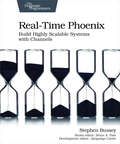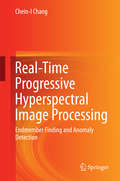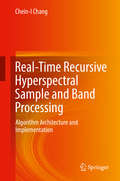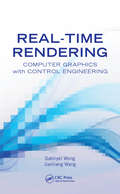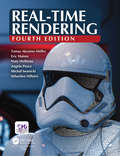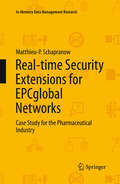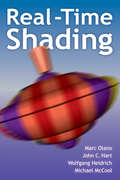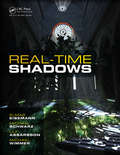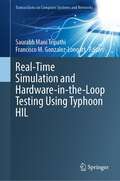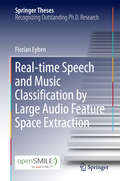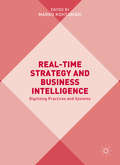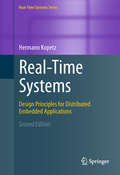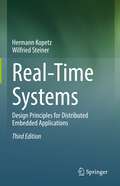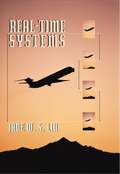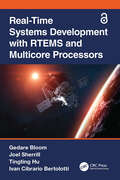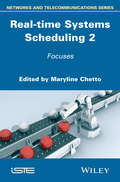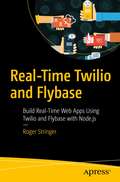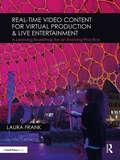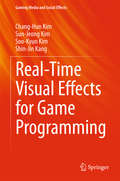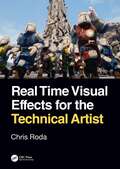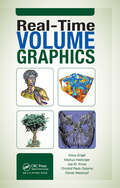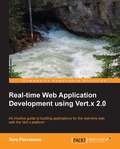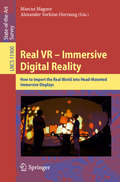- Table View
- List View
Real-Time Phoenix: Build Highly Scalable Systems with Channels
by Stephen BusseyGive users the real-time experience they expect, by using Elixir and Phoenix Channels to build applications that instantly react to changes and reflect the application's true state. Learn how Elixir and Phoenix make it easy and enjoyable to create real-time applications that scale to a large number of users. Apply system design and development best practices to create applications that are easy to maintain. Gain confidence by learning how to break your applications before your users do. Deploy applications with minimized resource use and maximized performance. Real-time applications come with real challenges - persistent connections, multi-server deployment, and strict performance requirements are just a few. Don't try to solve these challenges by yourself - use a framework that handles them for you. Elixir and Phoenix Channels provide a solid foundation on which to build stable and scalable real-time applications. Build applications that thrive for years to come with the best-practices found in this book. Understand the magic of real-time communication by inspecting the WebSocket protocol in action. Avoid performance pitfalls early in the development lifecycle with a catalog of common problems and their solutions. Leverage GenStage to build a data pipeline that improves scalability. Break your application before your users do and confidently deploy them. Build a real-world project using solid application design and testing practices that help make future changes a breeze. Create distributed apps that can scale to many users with tools like Phoenix Tracker. Deploy and monitor your application with confidence and reduce outages. Deliver an exceptional real-time experience to your users, with easy maintenance, reduced operational costs, and maximized performance, using Elixir and Phoenix Channels. What You Need:You'll need Elixir 1.9+ and Erlang/OTP 22+ installed on a Mac OS X, Linux, or Windows machine.
Real-Time Progressive Hyperspectral Image Processing
by Chein-I ChangThe book covers the most crucial parts of real-time hyperspectral image processing: causality and real-time capability. Recently, two new concepts of real time hyperspectral image processing, Progressive HyperSpectral Imaging (PHSI) and Recursive HyperSpectral Imaging (RHSI). Both of these can be used to design algorithms and also form an integral part of real time hyperpsectral image processing. This book focuses on progressive nature in algorithms on their real-time and causal processing implementation in two major applications, endmember finding and anomaly detection, both of which are fundamental tasks in hyperspectral imaging but generally not encountered in multispectral imaging. This book is written to particularly address PHSI in real time processing, while a book, Recursive Hyperspectral Sample and Band Processing: Algorithm Architecture and Implementation (Springer 2016) can be considered as its companion book.
Real-Time Recursive Hyperspectral Sample and Band Processing
by Chein-I ChangThis book explores recursive architectures in designing progressive hyperspectral imaging algorithms. In particular, it makes progressive imaging algorithms recursive by introducing the concept of Kalman filtering in algorithm design so that hyperspectral imagery can be processed not only progressively sample by sample or band by band but also recursively via recursive equations. This book can be considered a companion book of author's books, Real-Time Progressive Hyperspectral Image Processing, published by Springer in 2016.
Real-Time Rendering: Computer Graphics with Control Engineering (Automation and Control Engineering #49)
by Gabriyel Wong Jianliang WangConsumers today expect extremely realistic imagery generated in real time for interactive applications such as computer games, virtual prototyping, and scientific visualisation. However, the increasing demands for fidelity coupled with rapid advances in hardware architecture pose a challenge: how do you find optimal, sustainable solutions to accommodate both speed of rendering and quality? Real-Time Rendering: Computer Graphics with Control Engineering presents a novel framework for solving the perennial challenge of resource allocation and the trade-off between quality and speed in interactive computer graphics rendering. Conventional approaches are mainly based on heuristics and algorithms, are largely application specific, and offer fluctuating performance, particularly as applications become more complex. The solution proposed by the authors draws on powerful concepts from control engineering to address these shortcomings. Expanding the horizon of real-time rendering techniques, this book: Explains how control systems work with real-time computer graphics Proposes a data-driven modelling approach that more accurately represents the system behaviour of the rendering process Develops a control system strategy for linear and non-linear models using proportional, integral, derivative (PID) and fuzzy control techniques Uses real-world data from rendering applications in proof-of-concept experiments Compares the proposed solution to existing techniques Provides practical details on implementation, including references to tools and source code This pioneering work takes a major step forward by applying control theory in the context of a computer graphics system. Promoting cross-disciplinary research, it offers guidance for anyone who wants to develop more advanced solutions for real-time computer graphics rendering.
Real-Time Rendering, Fourth Edition: High-quality And Real-time Rendering With Dxr And Other Apis
by Eric Haines Duane C. Abbey Naty HoffmanThoroughly updated, this fourth edition focuses on modern techniques used to generate synthetic three-dimensional images in a fraction of a second. With the advent of programmable shaders, a wide variety of new algorithms have arisen and evolved over the past few years. This edition discusses current, practical rendering methods used in games and o
Real-time Security Extensions for EPCglobal Networks: Case Study for the Pharmaceutical Industry
by Matthieu-P. SchapranowThe transformation towards EPCglobal networks requires technical equipment for capturing event data and IT systems to store and exchange them with supply chain participants. For the very first time, supply chain participants thus need to face the automatic exchange of event data with business partners. Data protection of sensitive business secrets is therefore the major aspect that needs to be clarified before companies will start to adopt EPCglobal networks. This book contributes to this proposition as follows: it defines the design of transparent real-time security extensions for EPCglobal networks based on in-memory technology. For that, it defines authentication protocols for devices with low computational resources, such as passive RFID tags, and evaluates their applicability. Furthermore, it outlines all steps for implementing history-based access control for EPCglobal software components, which enables a continuous control of access based on the real-time analysis of the complete query history and a fine-grained filtering of event data. The applicability of these innovative data protection mechanisms is underlined by their exemplary integration in the FOSSTRAK architecture.
Real-Time Shading
by null Marc Olano null John Hart null Wolfgang Heidrich null Michael McCoolThis book covers real-time shading systems, their design and how they work. Procedural shading, long valued for off-line rendering and production animation is now possible on interactive graphics hardware. These developments are important for areas such as game development, product design, and scientific visualization, among others. The authors inc
Real-Time Shadows
by null Elmar Eisemann null Michael Schwarz null Ulf Assarsson null Michael WimmerImportant elements of games, movies, and other computer-generated content, shadows are crucial for enhancing realism and providing important visual cues. In recent years, there have been notable improvements in visual quality and speed, making high-quality realistic real-time shadows a reachable goal. Real-Time Shadows is a comprehensive guide to t
Real-Time Simulation and Hardware-in-the-Loop Testing Using Typhoon HIL (Transactions on Computer Systems and Networks)
by Saurabh Mani Tripathi Francisco M. Gonzalez-LongattThis book is an edited collection that explores the fundamental concepts of real-time simulation/hardware-in-the-loop testing using ‘Typhoon HIL’ for complex electrical systems. Typhoon HIL has recently emerged as a powerful tool in the rapidly growing field of ultra-high-fidelity controller-hardware-in-the-loop (C-HIL) simulations for power electronics, microgrids, and distribution networks. The book integrates the coverage of underlying theory and acclaimed methodological approaches and high-value applications of real-time simulation and hardware-in-the-loop testing—all from the perspectives of eminent researchers around the globe utilizing Typhoon HIL. This book serves as a valuable resource for engineers, academicians, researchers, experienced professionals, and research scholars engaged in /becoming familiarized with the real-time simulation of complex electrical systems using Typhoon HIL with a specific focus on hardware-in-the-loop testing.
Real-Time Software Design for Embedded Systems
by Hassan GomaaThis tutorial reference takes the reader from use cases to complete architectures for real-time embedded systems using SysML, UML, and MARTE and shows how to apply the COMET/RTE design method to real-world problems. The author covers key topics such as architectural patterns for distributed and hierarchical real-time control and other real-time software architectures, performance analysis of real-time designs using real-time scheduling, and timing analysis on single and multiple processor systems. Complete case studies illustrating design issues include a light rail control system, a microwave oven control system, and an automated highway toll system. Organized as an introduction followed by several self-contained chapters, the book is perfect for experienced software engineers wanting a quick reference at each stage of the analysis, design, and development of large-scale real-time embedded systems, as well as for advanced undergraduate or graduate courses in software engineering, computer engineering, and software design.
Real-time Speech and Music Classification by Large Audio Feature Space Extraction
by Florian EybenThis book reports on an outstanding thesis thathas significantly advanced the state-of-the-art in the automated analysis andclassification of speech and music. Itdefines several standard acoustic parameter sets and describes theirimplementation in a novel, open-source, audio analysis framework calledopenSMILE, which has been accepted and intensively used worldwide. The bookoffers extensive descriptions of key methods for the automatic classificationof speech and music signals in real-life conditions and reports on theevaluation of the framework developed and the acoustic parameter sets that wereselected. It is not only intended as a manual for openSMILE users, but also andprimarily as a guide and source of inspiration for students and scientists involvedin the design of speech and music analysis methods that can robustly handlereal-life conditions.
Real-time Strategy and Business Intelligence
by Marko KohtamäkiThis book discusses and conceptualizes practices on real-time strategy, focusing on the interplay between strategy and business intelligence. Combining strategic practices and business intelligence systems, the authors demonstrate how managerial practices can be developed in the age of digitization. Also developing the concept of strategic agility, the book provides perspectives from a range of disciplines including strategic practices and decision making, customer relationship management, human resource management, competitive intelligence, supplier network management and business intelligence systems. Presenting managerial frameworks and guidelines, Real-time Strategy and Business Intelligence explores how to improve utilization of business intelligence systems in real-time decision making. Providing practical and future-oriented insights backed by examples and best practices, the authors present a clearly conceptualized theoretical framework.
Real-Time Systems
by Hermann Kopetz"This book is a comprehensive text for the design of safety critical, hard real-time embedded systems. It offers a splendid example for the balanced, integrated treatment of systems and software engineering, helping readers tackle the hardest problems of advanced real-time system design, such as determinism, compositionality, timing and fault management. This book is an essential reading for advanced undergraduates and graduate students in a wide range of disciplines impacted by embedded computing and software. Its conceptual clarity, the style of explanations and the examples make the abstract concepts accessible for a wide audience." Janos Sztipanovits, Director E. Bronson Ingram Distinguished Professor of Engineering Institute for Software Integrated Systems Vanderbilt University Real-Time Systems focuses on hard real-time systems, which are computing systems that must meet their temporal specification in all anticipated load and fault scenarios. The book stresses the system aspects of distributed real-time applications, treating the issues of real-time, distribution and fault-tolerance from an integral point of view. A unique cross-fertilization of ideas and concepts between the academic and industrial worlds has led to the inclusion of many insightful examples from industry to explain the fundamental scientific concepts in a real-world setting. Compared to the first edition, new developments in complexity management, energy and power management, dependability, security, and the internet of things, are addressed. The book is written as a standard textbook for a high-level undergraduate or graduate course on real-time embedded systems or cyber-physical systems. Its practical approach to solving real-time problems, along with numerous summary exercises, makes it an excellent choice for researchers and practitioners alike.
Real-Time Systems: Design Principles for Distributed Embedded Applications
by Hermann Kopetz Wilfried Steiner"This book is a comprehensive text for the design of safety critical, hard real-time embedded systems. It offers a splendid example for the balanced, integrated treatment of systems and software engineering, helping readers tackle the hardest problems of advanced real-time system design, such as determinism, compositionality, timing and fault management. This book is an essential reading for advanced undergraduates and graduate students in a wide range of disciplines impacted by embedded computing and software. Its conceptual clarity, the style of explanations and the examples make the abstract concepts accessible for a wide audience."Janos Sztipanovits, DirectorE. Bronson Ingram Distinguished Professor of EngineeringInstitute for Software Integrated SystemsVanderbilt UniversityReal-Time Systems focuses on hard real-time systems, which are computing systems that must meet their temporal specification in all anticipated load and fault scenarios. The book stresses the system aspects of distributed real-time applications, treating the issues of real-time, distribution and fault-tolerance from an integral point of view. A unique cross-fertilization of ideas and concepts between the academic and industrial worlds has led to the inclusion of many insightful examples from industry to explain the fundamental scientific concepts in a real-world setting. Compared to the Second Edition, new developments in communication standards for time-sensitive networks, such as TSN and Time-Triggered Ethernet are addressed. Furthermore, this edition includes a new chapter on real-time aspects in cloud and fog computing.The book is written as a standard textbook for a high-level undergraduate or graduate course on real-time embedded systems or cyber-physical systems. Its practical approach to solving real-time problems, along with numerous summary exercises, makes it an excellent choice for researchers and practitioners alike.
Real-time Systems
by Jane W. S. LiuWritten by a renowned authority, this advanced text comprehensively covers the advances in real-time operating systems and communications networks, emphasizing research results that have been adopted in state-of-the-art systems.
Real-Time Systems Development with RTEMS and Multicore Processors (Embedded Systems)
by null Gedare Bloom null Joel Sherrill null Tingting Hu null Ivan Cibrario BertolottiThe proliferation of multicore processors in the embedded market for Internet-of-Things (IoT) and Cyber-Physical Systems (CPS) makes developing real-time embedded applications increasingly difficult. What is the underlying theory that makes multicore real-time possible? How does theory influence application design? When is a real-time operating system (RTOS) useful? What RTOS features do applications need? How does a mature RTOS help manage the complexity of multicore hardware?Real-Time Systems Development with RTEMS and Multicore Processors answers these questions and more with exemplar Real-Time Executive for Multiprocessor Systems (RTEMS) RTOS to provide concrete advice and examples for constructing useful, feature-rich applications. RTEMS is free, open-source software that supports multi-processor systems for over a dozen CPU architectures and over 150 specific system boards in applications spanning the range of IoT and CPS domains such as satellites, particle accelerators, robots, racing motorcycles, building controls, medical devices, and more.The focus of this book is on enabling real-time embedded software engineering while providing sufficient theoretical foundations and hardware background to understand the rationale for key decisions in RTOS and application design and implementation. The topics covered in this book include: Cross-compilation for embedded systems development Concurrent programming models used in real-time embedded software Real-time scheduling theory and algorithms used in wide practice Usage and comparison of two application programmer interfaces (APIs) in real-time embedded software: POSIX and the RTEMS Classic APIs Design and implementation in RTEMS of commonly found RTOS features for schedulers, task management, time-keeping, inter-task synchronization, inter-task communication, and networking The challenges introduced by multicore hardware, advances in multicore real-time theory, and software engineering multicore real-time systems with RTEMS All the authors of this book are experts in the academic field of real-time embedded systems. Two of the authors are primary open-source maintainers of the RTEMS software project.
Real-time Systems Scheduling 1: Fundamentals
by Maryline ChettoReal-time systems are used in a wide range of applications, including control, sensing, multimedia, etc. Scheduling is a central problem for these computing/communication systems since responsible of software execution in a timely manner. This book provides state of knowledge in this domain with special emphasis on the key results obtained within the last decade. This book addresses foundations as well as the latest advances and findings in Real-Time Scheduling, giving all references to important papers. But nevertheless the chapters will be short and not overloaded with confusing details. Coverage includes scheduling approaches for mono-core as well as multi-core platforms, dependent tasks, networks, and notably very tremendous recent advances in scheduling of energy constrained embedded systems. Other sophisticated issues such as feedback control scheduling and timing analysis of critical applications are also addressed. This volume can serve as a textbook for courses on the topic in bachelor and in more advanced master programs. It also provides a reference for computer scientists and engineers involved in the design or the development of Cyber-Physical Systems which require up-to-date real-time scheduling solutions.
Real-time Systems Scheduling 2
by Maryline ChettoReal-time systems are used in a wide range of applications, including control, sensing, multimedia, etc. Scheduling is a central problem for these computing/communication systems since it is responsible for software execution in a timely manner. This book, the second of two volumes on the subject, brings together knowledge on specific topics and discusses the recent advances for some of them. It addresses foundations as well as the latest advances and findings in real-time scheduling, giving comprehensive references to important papers, but the chapters are short and not overloaded with confusing details. Coverage includes scheduling approaches for networks and for energy autonomous systems. Other sophisticated issues, such as feedback control scheduling and probabilistic scheduling, are also addressed.This book can serve as a textbook for courses on the topic in bachelor's degrees and in more advanced master's degree programs. It also provides a reference for computer scientists and engineers involved in the design or the development of Cyber-Physical Systems which require up-to-date real-time scheduling solutions.
Real-Time Twilio and Flybase: Build Real-Time Web Apps Using Twilio and Flybase with Node.js
by Roger StringerUse Flybase and Twilio with Node.js to build real-time solutions and understand how real-time web technologies work. Written by the founder of Flybase, this book offers you practical solutions for communicating effectively with users on the modern web.Flybase.io is a web platform, used to store and retrieve data in real-time, as well as to send and receive real-time events such as triggers for incoming calls, incoming messages, agents logging off, etc. You will learn to send daily SMS messages, build an SMS call center to provide support to users, and build a call center to handle incoming and outgoing phone calls from the browser. You'll also build a group calling system to let groups send messages to each other: handy for managing events.Real-Time Twilio brings to light using the winning combination of Flybase and Twilio with Node.js for anyone with basic web development skills.What You'll LearnDevelop web apps with Flybase and TwilioBuild a live blogging tool and a group chat appCreate a click-to-call call center and a Salesforce-powered call centerSend daily SMS remindersDevelop a real-time call tracking dashboardWho This Book Is ForThose who want to learn to use Twilio and who wants to learn real-time development.
Real-Time Video Content for Virtual Production & Live Entertainment: A Learning Roadmap for an Evolving Practice
by Laura FrankReal-Time Video Content for Virtual Production & Live Entertainment looks at the evolution of current software and hardware, how these tools are used, and how to plan for productions dependent on real-time content. From rock concerts to theatre, live television broadcast to film production, art installations to immersive experiences, the book outlines the various applications of real-time video content – the intersection of gaming and performance that is revolutionizing how films are made and how video content is created for screens. Rather than render out a fixed video file, new tools allow for interactive video content that responds to audience activity, camera position, and performer action in real time. Combining software renderers with environmental information, video content is generated nearly instantaneously to simulate depth, creating a new world of Virtual Production. This book provides an overview of the current software and hardware used to create real-time content while also reviewing the various external technologies the real-time content is dependent upon. Case studies from industry experts appear in each chapter to reinforce the tools described, establish industry practice, and provide insight on a complex and rapidly growing discipline. Real-Time Video Content for Virtual Production & Live Entertainment prepares students and practitioners for a future working with real-time technologies and informs current entertainment technology professionals how to rethink about their old roles using these new tools. The book includes access to a companion website featuring web-based and video resources that expand on topics covered in the text. Each chapter has a unique page that points to example material, video presentations, and professional studies on chapter topics. You can visit the companion website at rtv-book.com.
Real-Time Visual Effects for Game Programming
by Chang-Hun Kim Sun-Jeong Kim Soo-Kyun Kim Shin-Jin KangThis book introduces the latest visual effects (VFX) techniques that can be applied to game programming. The usefulness of the physicality-based VFX techniques, such as water, fire, smoke, and wind, has been proven through active involvement and utilization in movies and images. However, they have yet to be extensively applied in the game industry, due to the high technical barriers. Readers of this book can learn not only the theories about the latest VFX techniques, but also the methodology of game programming, step by step. The practical VFX processing techniques introduced in this book will provide very helpful information to game programmers. Due to the lack of instructional books about VFX-related game programming, the demand for knowledge regarding these high-tech VFXs might be very high.
Real Time Visual Effects for the Technical Artist
by Chris RodaVisual effects (VFX) are one of the most complicated components of feature film and television creation. With advancements in such technologies as Ray Tracing and Virtual Reality, the visual quality of the real-time rendering engine is now rivaling feature film. Real-time rendering requires years of programming experience with advanced understanding in math and physics. As the power of the real-time rendering engine improves, so too do the interfaces for VFX creation. With limited technical understanding, artists can create VFX with the push of a button and tug of a slider. As powerful as the interfaces are, they can only expose a portion of the true potential of the rendering engine. Artists are limited by their understanding of the engine interface. Real Time Visual Effects for the Technical Artist is written for digital artists to explain the core concepts of VFX, common in all engines, to free them from interface bounds. Features: Introduces the reader to the technical aspects of real-time VFX Built upon a career of more than 20 years in the feature film VFX and the real-time video game industries and tested on graduate and undergraduate students Explores all real-time VFX in four categories: in-camera effects, in-material effects, simulations, and particles This book is written to complement undergraduate- or graduate-level courses focused on the fundamentals of modern real-time VFX. Chris Roda is a Technical Art instructor at the Florida Interactive Entertainment Academy (FIEA), a graduate degree program in interactive, real-time application development at the University of Central Florida. Early in his career, Chris was a visual effects artist in the film and television industries where he contributed visual effects for films such as Spider-Man, Titanic, and The Fifth Element. Before coming to FIEA, Chris was a CG Supervisor at Electronic Arts, where he worked on video game titles such as NCAA Football and Madden NFL Football. In addition to teaching, Chris works on generating tools and pipelines for the creation of immersive experiences: the amalgamation of the narrative of films, the interactivity of video games, and the immersion of theme parks.
Real-Time Volume Graphics
by null Klaus Engel null Markus Hadwiger null Joe Kniss null Christof Rezk-Salama null Daniel WeiskopfBased on course notes of SIGGRAPH course teaching techniques for real-time rendering of volumetric data and effects; covers both applications in scientific visualization and real-time rendering. Starts with the basics (texture-based ray casting) and then improves and expands the algorithms incrementally. Book includes source code, algorithms, diagr
Real-time Web Application Development using Vert.x 2.0
by Tero ParviainenA quick, clear, and concise tutorial-guide-based approach that helps you to develop a web application based on Vert.x.Real-time Web Application Development with Vert.x is written for web developers who want to take the next step and dive into real-time web application development.This book uses JavaScript (and some Java) to introduce the Vert.x platform, so basic JavaScript knowledge is expected. If you're planning to write your applications using some of the other Vert.x languages, all the techniques and concepts will translate to them directly. All you need to do is refer to the Vert.x API reference documentation to see the particular APIs for your language.
Real VR – Immersive Digital Reality: How to Import the Real World into Head-Mounted Immersive Displays (Lecture Notes in Computer Science #11900)
by Marcus Magnor Alexander Sorkine-HornungWith the advent of consumer-market Virtual Reality (VR) technology, the next revolution in visual entertainment is already on the horizon: real VR will enable us to experience live-action movies, sports broadcasts, concert videos, etc. in true visual (and aural) immersion. This book provides a comprehensive overview of the algorithms and methods that make it possible to immerse into real-world recordings. It brings together the expertise of internationally renowned experts from academia and industry who present the state of the art in this fascinating, interdisciplinary new research field. Written by and for scientists, engineers, and practitioners, this book is the definitive reference for anyone interested in finding out about how to import the real world into head-mounted displays.
